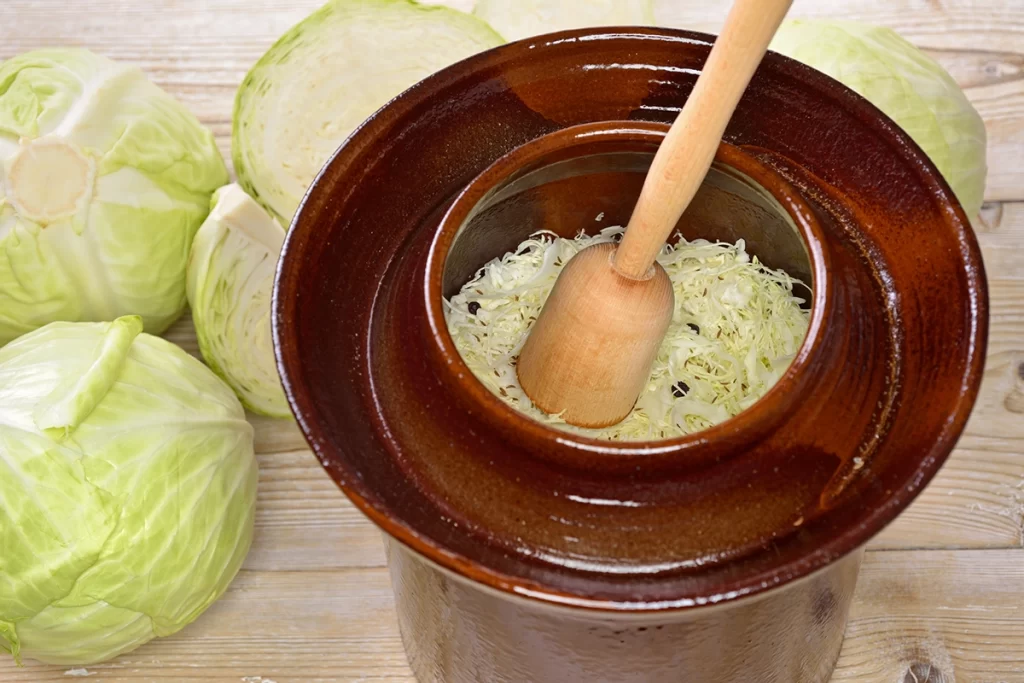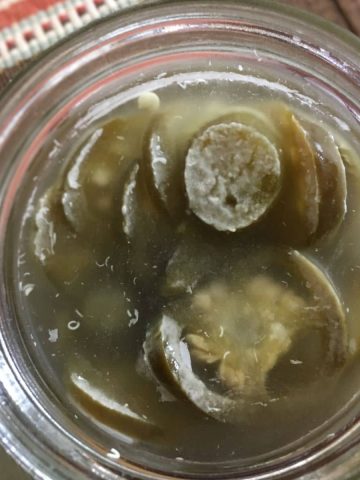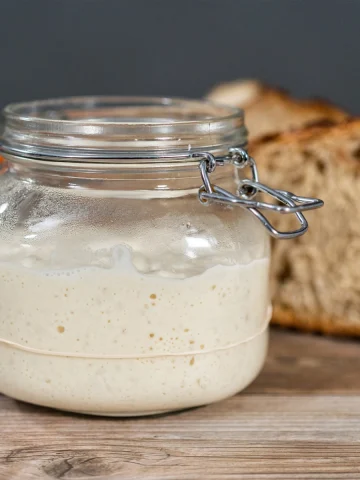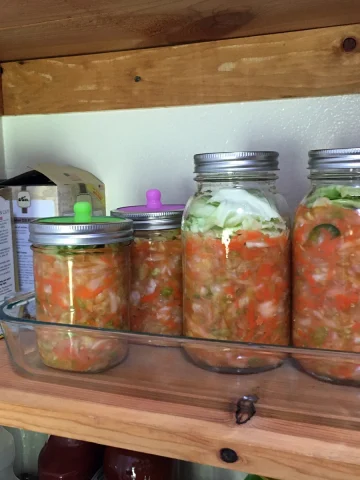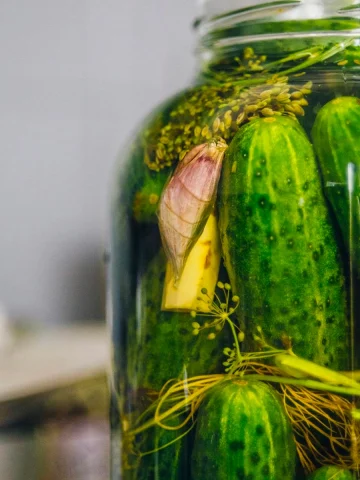Why are there bubbles in my sauerkraut?
Have you ever tried to make sauerkraut and noticed a lot of bubbles building up on the surface or in the brine? Or saw no bubbling activity and wondered: am I doing this right?
Is sauerkraut suposed to be bubbly? Is it fermenting correctly, or am I doing something wrong?
In this post, I will demystify all your questions about bubbles in sauerkraut and how to determine if it is safe to eat.
Does saurerkaut bubble when fermenting?
Yes, sauerkraut is supposed to be bubbly while fermenting.
Most vegetables with a lot of water will produce bubbles during fermentation.
During the first few days of fermenting sauerkraut, it is common to see little air bubbles which are CO2 gasses making their way to the top of the jar. The bubbling activity is normal and a good sign the fermentation process is working.
What causes sauerkraut to bubble?
First, why do bubbles appear during the making of sauerkraut?
Fermentation is the result of yeast converting sugar into alcohol and carbon dioxide. The CO2 gas will escape into the atmosphere causing the bubbles you see.
Friendly bacteria produced by the lactic acid fermentation process feed on the sugar in the veggies and release gases due to their feeding activity. After a few days at room temperature, these gases are generally visible as bubbles throughout the jar, which is a strong indication that the process is working successfully.
Even if a batch of sauerkraut or any other fermented vegetable is not bubbling like you are used to seeing, don't toss it out! Keep it and consider the other signs of a good ferment.
During the first week of fermenting, vegetables become anaerobic. Fermentation happens because salt-tolerant, oxygen-utilizing microorganisms increase in the first stage of vegetable fermentation.
These microorganisms will consume most of the oxygen within the liquid.
After about two days, they use up the oxygen and make the vegetable ferment anaerobic.
Everything submerged below the brine is safe from oxygen exposure after this occurs. To keep things submerged, use a fermentation weight.
Once most of the oxygen is consumed by the aerobic microbes, the aerobic microbes no longer can survive and die off.

This makes room for anaerobic heterolactic fermentative bacteria called Leuconostoc spp., which cause CO2 bubbles, acetic acid, and lactic acid.
The Leuconostoc bacteria continue contributing to anaerobiosis by producing large amounts of CO2. You will see this happen by observing bubbles in the fermentation.
The Leuconostoc bacteria produce so much CO2 and acids that they can no longer survive in the environment and die off.
This repeated process of microbes thriving, self-limiting, then dying is called bacterial succession.
Which leads to Lactobacillus spp. they are being able to dominate and thrive. They are homolactic fermenters and produce ample amounts of one substance: lactic acid.
Lactobacillus thrive on the combination of salt, anaerobic conditions, and acid. They produce enough acid to preserve fermented vegetables fully.
The Lactobacillus can survive for many months in refrigerated conditions once they are the dominant population.
So To Break it Down:
Lack of oxygen does not preserve the vegetables.
Salt does not preserve the vegetables.
It is the combination of a lack of oxygen combined with salt that encourages certain probiotic microorganisms to produce acids, and those acids are what preserve the vegetables.
How long should sauerkraut bubble?
Sauerkraut can bubble for a few days up to several weeks. So many variables go into fermenting vegetables, including sauerkraut that it is impossible to give a firm timeline for how long the bubbles will remain active?
Usually, sauerkraut bubbles are active within the first week, and then they die down.
However, I've seen active bubbles in a jar of sauerkraut three weeks into fermenting.
The number of bubbles or lack thereof does not determine if the batch of sauerkraut will turn out well.
There are no bubbles in my sauerkraut. Is it safe to eat?
Don't worry, the bubbles are most likely in your jar; you just can't see them yet. If you have packed cabbage or any vegetable mixture down firmly as you should, it is possible the bubbles are trapped between the layers, and you can't see them.
Furthermore, you may no longer see many bubbles if it is past the first week.
Why isn't my sauerkraut bubbling?
Bubbling in fermentation can vary considerably. Vegetables with lots of water will tend to bubble a lot. At the same time, thicker mixtures such as chutney, mustard, and ketchup ferments may not bubble at all.
Tips if You Don't See Bubbles in your Sauerkraut
Tap the Jar: Gently give the jar a few taps to help release the air pockets inside.
Place the jar in a warm spot: vegetables will happily ferment at a temperature range of 65-70°F (18-21°C). If set in a cool place, the process will take a little longer, and the bubble production will be reduced.
Use organic cabbage: Mass-produced vegetables are often irradiated to increase shelf life, leaving the vegetable devoid of microbial life. Microbes are needed for fermentation. Buy organic to ensure you start each recipe with a quality vegetable containing the microbes needed to ferment.
Signs of a Healthy Fermentation:
Beyond bubbles in a ferment, there are several more signs that fermentation is working correctly. Texture, color change, and sour taste are common signs.
The texture of the vegetables will become a little softer. The color of the cabbage will dull to a soft or light green. Give the sauerkraut a taste test to see how the sourness level has developed from the lactic acid. If the ferment tastes sour enough for you, then it is ready to eat. Likewise, if you smell a foul odor, you know it has gone bad. Toss it out!
How safe is it to ferment vegetables?
Lacto-fermentation is safe if you use the correct salt-to-water ratios for the brine. When the brine creates an environment where harmful bacteria can't survive, it makes the food safe and healthy to eat.
Letting the ferment go through all the stages of fermentation is also key to a healthy end product. Conduct a taste, smell, and visual test to tell if your ferment is safe to eat. If it smells rancid, like something rotting in your fridge, something went wrong and should be thrown out.
Tips for a safe fermentation and less food spoilage
Follow these tips to make a gut-healthy delicious, and safe-to-eat sauerkraut.
- Use fresh organic ingredients. Buy the best cabbage you can find. Starting with organic cabbage is best. Always avoid old cabbage or vegetables for your fermentation recipes.
- Practice good hygiene – Clean your vegetables. Wash your tools, cutting board, bowls, jars, and hands with hot, soapy water before use.
- Use a good amount of salt - it is essential to create an inhospitable environment for harmful bacteria to survive, precisely what the salt does to a ferment.
- Use the right kind of salt - Avoid iodized salt, table salt, or any salt with additives that can make the ferment go bad. I recommend fine, high-quality sea salt.
- Purified water – Always use distilled or purified water to ferment vegetables. Tap water can contain chemicals like chlorine that harm good bacteria and lead to a bad ferment.
- Ferment at the right temperature: The live bacteria in sauerkraut will thrive if the temperature is between 70 and 80 degrees Fahrenheit. Of course, there are exceptions; if you are fermenting in the winter, you can still have a successful ferment in temperatures in the 60s. The fermentation process might talk longer due to the cooler temperatures, but that is ok.
More Sauerkraut Questions Answered:
- How to Fix Salty Sauerkraut?
- How to Fix Sauerkraut that is too sour?
- Why Sauerkraut Turns Brown on Top?
- How Long To Ferment Sauerkraut?
- Does Cooking Sauerkraut Kill the Probiotics?
Final thoughts
When it comes to bubbles in your sauerkraut or any fermented vegetable, there are a lot of factors that come into play.
We talked about too many bubbles in sauerkraut, no bubbles appear in sauerkraut, why there are bubbles in fermented foods, and how to determine if your sauerkraut is safe to eat.
Overall, sauerkraut with lots of bubbles and no bubbles at all, you can still have a safe and gut-healthy batch of sauerkraut to eat.
Take the time to go through all the options to determine if your batch of sauerkraut is safe to eat. Check the texture of the vegetables, the color, smell, and is it staying below the brine.
Overall, don't sweat it if you have to toss out a few jars of sauerkraut initially. I've done it several times. Fermenting vegetables is a learning process that is well worth the investment.
Keep on Fermenting!

